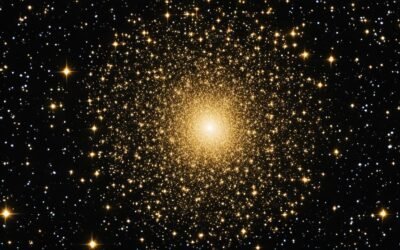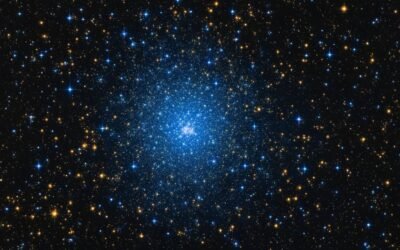Welcome to the mesmerizing world of Messier 30, also known as M30 or NGC 7099, a breathtaking globular cluster nestled in the constellation of Capricornus. Discovered by Charles Messier in 1764, this celestial object has enchanted astronomers for centuries with its beauty and astronomical significance. Join us as we embark on a journey to uncover the wonders of Messier 30 and delve into its unique properties.
Key Takeaways:
- Messier 30 (M30) is a captivating globular cluster located in the constellation of Capricornus.
- Discovered by Charles Messier in 1764, Messier 30 has fascinated astronomers with its beauty and astronomical significance.
- With its ancient age, unique properties, and distant location, Messier 30 offers a fascinating subject for exploration and observation.
- Messier 30 has a diameter of approximately 93 light years and lies about 27,140 light years away from Earth.
- Observing Messier 30 can be done with binoculars or a telescope, allowing for a closer look at its individual stars and core region.
The Characteristics of Messier 30
Messier 30, also known as M30 or NGC 7099, is a remarkable globular cluster with unique characteristics that provide valuable insights into the formation and evolution of celestial objects. Explore the fascinating features of Messier 30 below:
Size: Messier 30 has a diameter of about 93 light years, making it one of the larger globular clusters in the universe. Its expansive size allows for a rich concentration of stars within its boundaries.
Distance: Located approximately 27,140 light years away from Earth, Messier 30 dazzles observers from a significant distance. Its remote position in the cosmos adds to its allure and makes it an exciting target for astronomical exploration.
Age: With an estimated age of 12.93 billion years, Messier 30 is a relic from the early universe. Its ancient nature provides astronomers with a window into the early stages of galaxy formation and stellar evolution.
Mass: The cluster boasts a mass roughly 160,000 times that of our Sun, which contributes to its gravitational pull and influences the dynamics of its stellar population. The immense mass of Messier 30 shapes its overall structure and behavior.
As you can see, Messier 30 exhibits fascinating characteristics that set it apart from other globular clusters in the cosmos. Its size, distance, age, and mass all contribute to its unique nature and make it an intriguing subject for scientific study and observation.
The Observation of Messier 30
While Messier 30 may not be visible to the naked eye, it can be easily observed with a pair of 10×50 binoculars. When viewed through binoculars, Messier 30 appears as a slightly elongated hazy patch of light, spanning about 4 arc minutes in width. This cluster of stars becomes even more fascinating when observed through a telescope.
With a telescope, the individual stars within Messier 30 become visible, offering a closer look at its intricate structure. The core region of the cluster, which measures about 0.12 arc minutes in width, can be observed in stunning detail.
The best time to observe Messier 30 is during the summer months when it is most visible in the night sky. Its position in the constellation of Capricornus makes it easier to locate and track.
| Observation Method | Visibility | Details |
|---|---|---|
| Binocular Viewing | Clear | Messier 30 appears as a slightly elongated hazy patch of light, around 4 arc minutes wide. |
| Telescope Observation | Enhanced | Individual stars within the cluster become visible, and the core region can be observed in detail. |
Observing Messier 30 through different instruments provides unique insights into its composition and structure. Whether you choose to use binoculars or a telescope, get ready to embark on a mesmerizing journey to explore the wonders of the celestial world.
The Origin and Orbit of Messier 30
Messier 30, also known as M30 or NGC 7099, has a fascinating origin and orbit that contribute to its scientific interest and unique characteristics. It is believed to have originated from a satellite galaxy that was incorporated into the Milky Way, adding to its historical and cosmological significance. The cluster’s retrograde orbit through the inner galactic halo further supports the idea that it was acquired rather than forming within our galaxy.
Currently, Messier 30 is positioned approximately 22,200 light years from the galactic center, slightly closer than the Sun. This location within the galactic halo provides an excellent vantage point for studying the cluster and exploring its properties in relation to the Milky Way. Its distance and unique orbit offer valuable insights into the formation, evolution, and dynamics of globular clusters within galactic systems.
The origin of Messier 30 from a satellite galaxy and its retrograde orbit through the inner galactic halo make it a captivating subject for scientific study, offering clues about the complex interactions between galaxies and the structures that form within them.
Messier 30’s Orbit and Position
| Property | Value |
|---|---|
| Origin | Satellite galaxy incorporated into the Milky Way |
| Orbit | Retrograde orbit through the inner galactic halo |
| Position in the Milky Way | About 22,200 light years from the galactic center |
The unique origin and orbit of Messier 30 contribute to our understanding of the complex interactions between galaxies and the formation of galactic structures. By studying its properties and position within the Milky Way, astronomers gain valuable insights that shed light on the fascinating processes that shape our universe.
The Structure and Density of Messier 30
Messier 30, a globular cluster in the constellation of Capricornus, exhibits fascinating structural characteristics and a notable density. As a result of the core collapse phenomenon, the cluster’s core has become denser, concentrating a significant amount of stellar mass within a narrow diameter of approximately 0.9 light years. This dense core region offers a unique environment for interactions between stars, leading to the creation of binary star systems.
The density of stars in Messier 30 is noticeably higher in the core, gradually decreasing towards the outer regions of the cluster. This creates a density gradient, with the central region consisting of a higher proportion of higher mass stars. As a result, the cluster displays a bluer color gradient towards its middle, reflecting the prevalence of younger and more massive stars in this area.

Understanding the structure and density of Messier 30 provides valuable insights into the formation and evolution of globular clusters. By investigating the intricate interactions between stars in the dense core and studying the distribution of stellar masses across the cluster, astronomers can gain a deeper understanding of the dynamics and evolution of these fascinating celestial objects.
Notable Features and Observations of Messier 30
Messier 30, also known as M30, is a globular cluster that boasts several notable features and observations. Let’s dive into the intriguing characteristics of this celestial wonder.
Variable Stars in Messier 30
Messier 30 is home to 12 known variable stars, captivating astronomers with their fluctuations in brightness over time. These stars provide valuable insights into stellar evolution and the dynamic nature of globular clusters.
Blue Stragglers: Old Stars with Youthful Appearance
One of the fascinating phenomena in Messier 30 is the presence of blue stragglers. These stars, despite their age, appear bluer and younger due to interactions and mass transfer within the cluster. Their unique characteristics challenge our understanding of stellar evolution and dynamics within globular clusters.
Red Giant Stars and Magnitude
Within Messier 30, you’ll find some of the brightest red giant stars with a visually magnitude of 12.1. These evolved stars exhibit immense size and radiance, adding to the cluster’s splendor. Additionally, the brightest horizontal branch giants have a magnitude of 15.1.
Optical Counterparts Revealed
Through extensive observations, astronomers have identified optical counterparts for several X-ray sources within Messier 30. This includes cataclysmic variables, which are binary star systems undergoing intense interactions and eruptions. Understanding these optical counterparts helps unravel the complex nature of stellar companionship within the cluster.
Explore the stunning visual representations and scientific discoveries related to these notable features of Messier 30:
| Variable Stars | Blue Stragglers | Red Giant Stars | Optical Counterparts |
|---|---|---|---|
| 12 known variable stars | Old stars that appear bluer and younger | Brightest red giant stars: magnitude 12.1 | Identified optical counterparts for X-ray sources |
Witness the beauty and scientific significance of Messier 30 as we unravel more historical discoveries and observations in the upcoming sections.
Historical Discoveries and Observations of Messier 30
Throughout history, Messier 30 has intrigued astronomers with its unique properties and discoveries. Let’s explore the significant observations that have contributed to our understanding of this captivating globular cluster.
In 1764, the renowned astronomer Charles Messier made a groundbreaking discovery when he first observed Messier 30. Initially, he mistook it for a nebula, but later observations by Sir William Herschel unveiled its true nature as a brilliant star cluster with a dense center. Herschel’s observations shed light on the cluster’s structure and inspired further investigations into its intriguing features.
“Messier 30 is a fascinating cluster, rich in stars and displaying a dense core structure.” – Sir William Herschel
In more recent times, advancements in technology have allowed for even more detailed observations of Messier 30. The Chandra X-ray Observatory, launched by NASA in 1999, has been instrumental in detecting low-luminosity X-ray sources within the cluster. These observations have provided valuable insights into the presence of cataclysmic variables and quiescent low-mass X-ray binaries, expanding our knowledge of the cluster’s stellar population and dynamics.
By combining historical discoveries with state-of-the-art observations, astronomers have unraveled the mysteries of Messier 30, uncovering its unique characteristics and contributing to our broader understanding of the universe.
Continue reading to learn about the various ways in which Messier 30 can be observed and studied using different instruments.

Observation of Messier 30 by the Chandra X-ray Observatory has provided important insights into its stellar population and dynamics.
Observing Messier 30 Through Different Instruments
Messier 30, with its captivating beauty and unique structure, offers stunning opportunities for astrophotography. Whether you’re an amateur or a seasoned photographer, capturing detailed images of this celestial wonder will surely leave you in awe.
When observing Messier 30 through a telescope, you’ll have the privilege of witnessing the resolved core and individual stars. This allows for a deeper understanding of the cluster’s dynamics and reveals intricate details that are otherwise unseen. With its magnificent structure and ancient age, Messier 30 presents a rich palette for photographers to explore and capture.
Astrophotography Tips for Messier 30:
- Use a DSLR or a dedicated astronomical camera for optimal results.
- Experiment with different exposure times to capture the subtle details of the cluster.
- Consider using a star tracker or equatorial mount to counteract the Earth’s rotation and ensure sharp images.
- Use narrowband filters to enhance specific features and bring out the cluster’s unique colors.
- Take multiple images and stack them to reduce noise and improve overall image quality.
While a telescope provides a close-up view of Messier 30, binoculars offer a great starting point for observing this breathtaking cluster. With binoculars, you can easily locate and appreciate the hazy patch of light that characterizes Messier 30. Although you won’t see the individual stars, the binoculars will still reveal the cluster’s true beauty, leaving you eager for further exploration.
Capturing the essence of Messier 30 through astrophotography and exploring its wonders with binoculars or a telescope unlocks a world of celestial beauty. Whether you’re an enthusiast or a professional, witnessing the intricate details and unique structure of this ancient globular cluster is a truly mesmerizing experience.
| Instrument | Advantages | Limitations |
|---|---|---|
| Binoculars | Offers a wide field of view for easy locating and observing Messier 30 Provides a glimpse of the cluster’s hazy patch of light Quick setup and portability | No individual star resolution Limited magnification |
| Telescope | Enables the observation of resolved core and individual stars Offers higher magnification for detailed exploration Unlocks a deeper understanding of the cluster’s dynamics | Requires a stable mount for best results May require additional accessories for astrophotography |
Conclusion
Summing up, Messier 30, also known as M30 or NGC 7099, is a captivating globular cluster that offers astronomers a wealth of fascinating features and scientific discoveries. With its ancient age, unique structure, and distant location, Messier 30 provides an ideal subject for exploration and observation. Whether you choose to observe it through binoculars, telescopes, or capture its beauty through astrophotography, this celestial wonder continues to inspire researchers and stargazers alike.
The cluster’s characteristics, such as its diameter of 93 light years, distance of 27,140 light years from Earth, estimated age of 12.93 billion years, and mass 160,000 times that of the Sun, contribute to its intriguing nature. Messier 30’s origin from a satellite galaxy and its retrograde orbit through the inner galactic halo further add to its scientific interest.
Observing Messier 30 through different instruments reveals its unique structure, density gradient, and notable features such as variable stars, blue stragglers, and red giant stars. Over the years, notable discoveries and observations have been made, from Charles Messier’s initial discovery in 1764 to the Chandra X-ray Observatory’s detection of low-luminosity X-ray sources within the cluster.
Whether you’re an experienced astronomer or an enthusiast looking to explore the wonders of the cosmos, Messier 30 offers a captivating glimpse into the mysteries of the universe. Its beauty and scientific significance will continue to inspire generations of researchers and stargazers to unravel the secrets of this ancient celestial wonder.
FAQ
What is Messier 30?
Messier 30 is a globular cluster of stars in the constellation of Capricornus. It was discovered by Charles Messier in 1764 and is also known as M30 or NGC 7099.
How big is Messier 30?
Messier 30 has a diameter of about 93 light years, making it one of the larger globular clusters.
How far away is Messier 30?
Messier 30 is approximately 27,140 light years away from Earth.
How old is Messier 30?
Messier 30 has an estimated age of 12.93 billion years.
What is the mass of Messier 30?
Messier 30 has a mass of about 160,000 times that of the Sun.
Can Messier 30 be seen with the naked eye?
No, Messier 30 is not visible to the naked eye, but it can be easily observed with a pair of 10×50 binoculars.
What does Messier 30 look like?
Messier 30 appears as a slightly elongated hazy patch of light, with a width of about 4 arc minutes. With a telescope, individual stars within the cluster become visible, and the core region can be observed.
When is the best time to observe Messier 30?
The best time to observe Messier 30 is during the summer months.
Where did Messier 30 come from?
Messier 30 is believed to have originated from a satellite galaxy that was incorporated into the Milky Way.
What is the orbit of Messier 30?
Messier 30 has a retrograde orbit through the inner galactic halo, suggesting that it was acquired rather than forming within our galaxy.
What is the structure of Messier 30?
Messier 30 has undergone core collapse, resulting in a dense core with a concentration of mass. It also exhibits a density gradient, with a higher proportion of higher mass stars in the central region, resulting in a bluer color gradient towards the middle of the cluster.
Are there any notable features in Messier 30?
Messier 30 contains 12 known variable stars and blue stragglers, and it hosts bright red giant stars and horizontal branch giants. Optical counterparts have been identified for some of the X-ray sources within the cluster.
Who discovered Messier 30?
Messier 30 was discovered by Charles Messier in 1764, initially mistaking it for a nebula. Sir William Herschel later resolved it into a brilliant cluster and noted its dense center.
Can Messier 30 be observed through different instruments?
Yes, Messier 30 offers stunning opportunities for astrophotography. With a telescope, the resolved core and individual stars can be observed, while binoculars provide a great starting point for viewing the cluster’s hazy patch of light.
What can we learn from Messier 30?
Messier 30 provides valuable insights into the formation and evolution of globular clusters and offers a captivating subject for scientific exploration and observation.






